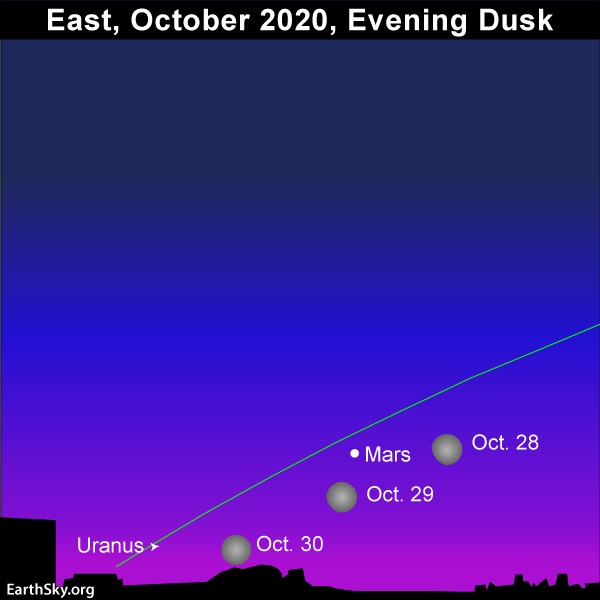
These next several nights – October 28, 29 and 30, 2020 – watch for the bright waxing gibbous moon to sweep by the red planet Mars. Earlier this month, Mars came closest to Mars for this two-year period, and, in turn, Mars has been shining brilliantly in Earth’s sky. Enjoy Mars right now while it’s still bright and beautiful! The moon can help you find it in the next few nights. Full moon will come on October 31. It’ll be the 2nd full moon of this month, which many will call a Blue Moon. A Blue Moon near red Mars on October 31? Cool!
This’ll also be the second time that the moon pairs up with Mars in October, having done so previously on the night of October 2-3, 2020. As for October’s first full moon – the Northern Hemisphere’s Harvest Moon – it fell on October 1, 2020.
This month – October 2020 – Mars supplanted the king planet Jupiter as the fourth brightest celestial body to light up the heavens (after the sun, moon and the planet Venus, respectively). In November 2020, however, Jupiter will reclaim its accustomed spot in the heavenly hierarchy. Earth, in its faster and smaller orbit around the sun, is now traveling away from Mars. Therefore, the red planet is slowly bur surely dim in Earth’s sky.
Nonetheless, Mars will continue to shine more brilliantly than a 1st-magnitude star for the remainder of 2020.
The moon will pass 3 degrees to the south of Mars on October 29, 2020, at 16:13 UTC. That’s during the daylight hours October 29 at North American time zones, when the moon and Mars will still be below our horizon.
From North America, we’ll see the moon to the southwest of Mars as darkness falls on October 28, and then to the southeast of Mars at nightfall October 29.
Our planet Earth, in our faster and smaller orbit around the sun, laps Mars in periods of about 2 years and 2 months. Whenever Earth passes in between Mars and the sun, Mars is said to be at opposition. It’s at opposition that Mars is opposite the sun in Earth’s sky. It’s at or around opposition that Earth comes closest to Mars for the year, and Mars, in turn, shines most brilliantly in Earth’s sky. Mars’ most recent opposition took place on October 13, 2020, and Mars’ next opposition will happen on December 28, 2022.

Because Mars has such an eccentric (oblong) orbit around the sun, Martian oppositions are far from equal. Especially close oppositions happen in late August/early September, and especially far oppositions in late February/early March.
Yet, the next 6 oppositions of Mars will be farther away than this year’s, and Mars won’t showcase a brighter production until the opposition of September 15, 2035. We give the distances for Mars for the oppositions from 2020 to 2035, inclusive, in terms of the astronomical unit (AU). The astronomical unit is the sun-Earth distance of about 93 million miles or 150 million km.
Martian oppositions 2020 to 2035
2020 October 13: 0.41 AU
2022 December 28: 0.54 AU
2025 January 16: 0.64 AU
2027 February 19: 0.68 AU
2029 March 25: 0.65 AU
2031 May 4: 0.55 AU
2033 June 28: 0.42 AU
2035 September 15: 0.39 AURead more: The cycle of close and far Martian oppositions
Bottom line: Use the bright waxing gibbous moon to find the red planet Mars in late October 2020. This is the brightest that you’ll see Mars for another 15 years!
Read more: Blue Moon and Mars on Halloween
Source:
https://earthsky.org/tonight/moon-mars-meet-in-late-october